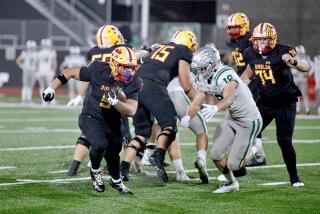Much More Than a Pilot Program
- Share via
Each season produces at least one team that catches the world off guard and you could say this year’s surprise definitely came out of the (wild) blue (yonder).
Our storybook team is climbing fast in the polls after starting unranked.
Our team is coming off a nonwinning season and figured to have been eliminated from bowl championship series consideration on Sept. 14.
Our team has won its way into hearts and minds and, more important, into ESPN’s late-night Saturday time slot.
Notre Dame?
OK, technically the Irish also qualify as overachieving upstarts -- an unranked team coming off a nonwinning season -- but we were thinking more of Notre Dame’s opponent this week, Air Force.
Air Force is 6-0, ranked 18th and different from Notre Dame (6-0 and No. 7) if only because the Irish don’t turn away recruits who can’t fit into jet fighter cockpits.
Air Force remains an anomaly in that it leads the nation in rushing while it continues to confound its two service academies rivals, Army and Navy.
How and why Air Force has managed to produce top-flight pilots and a quality football program has Pentagon generals scratching their heads.
“Oh, there’s a lot of bragging rights among the service academies,” Chad Hennings, the former Air Force and Dallas Cowboy player, said this week. “It’s always good just to rub it in their faces, basically.”
Here’s the rub:
Since he took over as Air Force coach in 1984, Fisher DeBerry is 147-78-1 and has a 31-6 record against Army and Navy.
DeBerry has won more games than any other service academy coach, including Army’s famed Red Blaik.
DeBerry has had only two nonwinning seasons -- last year’s team was 6-6 -- has taken the Falcons to 11 bowl games, and has accomplished all this while Army and Navy have done about-faces.
Army, 0-6 this year, has had only eight winning seasons since 1984, is 14-47 since 1997 and was 1-10 as recently as 2000.
Navy, 1-15 in its last 16 games, has had six coaches who have amassed a record of 73-159-1 since 1982.
Air Force, meanwhile, does not only have a model program among the service academies; it has a model program, period.
This year, the Falcons seem a cinch to wrap up their sixth consecutive Commander in Chief’s trophy and may be on the precipice of breaking the BCS sound barrier.
A victory over Notre Dame in Colorado Springs on Saturday would put Air Force in rarefied air.
“Their season is pivoting on this one,” Hennings said. “If they get by this one, they are positioning themselves for great things.”
Notre Dame has a 20-5 record against Air Force but has always struggled against the option attack. The last two meetings were decided in overtime, Air Force winning at Notre Dame in 1996 and losing in 2000.
DeBerry’s triple option, which infuriates opposing coordinators used to stopping conventional offenses, has never been better. The Falcons average a nation-leading 339.2 yards rushing a game, led by junior quarterback Chance Harridge, who has scored 15 touchdowns.
Air Force has crushed Northwestern, 52-3; upset California, 23-21, and last week exacted 52-9 revenge against Brigham Young, which scored a 30-point victory last year.
“You’re never going to stop that offense,” Cal Coach Jeff Tedford said after losing to Air Force on Sept. 21.
DeBerry’s options are limited, though, he says, because the academy cannot compete with other Division I-A programs for top-notch players.
“We’re never going to be as big as any of our opponents, but that doesn’t mean we can’t be as quick or not run as well, or certainly be as strong,” DeBerry said.
Because some Air Force players become jet pilots, the academy is restricted as to the size of the players it recruits. DeBerry says the academy can beef players up while they’re playing football--a 230-pound freshman may gain 40 pounds--but those players must lose that weight before graduation to meet academy limits.
“It’s a challenge to them every spring, our seniors, to lose their weight,” DeBerry said.
To counter the size disadvantage, Air Force has employed a precision option attack in an era when most major college schools have become pass-happy.
“It’s not something opposing teams see every week,” DeBerry said.
So What Gives?
Army and Navy, while running similar offenses, have largely failed to match Air Force’s success and, frankly, they’re not happy about it (Army recently dumped the option for a more conventional offense).
Privately, while praising DeBerry’s success, officials from the rival academies grumble about Air Force.
One Army insider said, “Young guys want to fly jets, not drive tanks.”
A Navy man said Air Force simply puts more emphasis on football while Navy’s answer “has been to fire the coach.”
Other advantages?
* Army and Navy followers note that Air Force’s prep school, which feeds nonqualifiers into the academy, is right across the street. (Navy’s is in Rhode Island.)
* Unlike the other academies, Air Force allows players with NFL potential out of their military commitments after two years, making it a more desirable destination for players with pro aspirations.
* Conference ties. Years ago, Air Force figured out the benefits of conference membership. A longtime member of the Western Athletic Conference, Air Force is now in the Mountain West, generally considered the best of the non-BCS conferences. This is also an advantage in attracting players. To keep up, Army recently joined Conference USA. Navy, however, remains an independent.
* Geography. Air Force is closer to two of the three best recruiting hotbeds in the country, Texas and California. Thirty players on this year’s Air Force roster are from those two states.
* Academic standards. Army and Navy claim that Air Force is easier
.* Float-your-boat theory. Air Force players get to remain in the United States after graduation, whereas Navy recruits may end up on the high seas.
“Air Force coaches tell recruits, ‘You don’t have to go on a ship for six months,’ ” the Navy man said. “That’s a factor.”
* Fisher DeBerry. There’s no substitute for consistency. Air Force has had one coach, running the same offense, for more than 18 years.
“That’s important,” DeBerry said, “because it takes you a couple of years to learn to recruit at an academy.”
Hurry-Up Offense
Fun with numbers: The combined record of the current and former Florida football coaches is 6-6. Ron Zook is 4-3 in his first year with the Gators and Steve Spurrier’s Washington Redskins are 2-3. Here’s why Spurrier will get more time to turn things around: Zook has already lost two home games this year by a total of 54 points. In 12 years at Florida, Spurrier lost five home games by a total of 25 points.
More on this week’s game of the week: Air Force averages 339 yards a game rushing; Notre Dame’s defense has given up only 457 rushing yards all season. Air Force gained 476 yards rushing in one game, against Northwestern.
Air Force junior quarterback Harridge, an unheralded player from Houston County High in Bonaire, Ga., says one of his favorite all-time movies is “Rudy.” Harridge, however, says he will not seek inspiration from the film this week. Harridge is already being compared to some of the great Air Force option quarterbacks, among them Blane Morgan. “I’ve only had six games,” Harridge says. “Ask me that after my career is over.”
There could very well be another mess this year in the BCS standings, which will be unveiled Monday. There are 10 unbeaten Division I teams remaining but only two potential head-to-head, regular-season matchups: We know a loser will emerge from Notre Dame-Air Force, but Miami and Virginia Tech could be undefeated when they play Dec. 7.
Neither Air Force nor Bowling Green has a flying Falcon’s chance to play for the national title, even if both teams go undefeated, leaving eight remaining undefeated teams jockeying for national title position.
Quick handicap of the Fiesta Bowl field: 1. Miami-Virginia Tech winner. Miami has only one tough game, Nov. 9 at suddenly so-so Tennessee, and Virginia Tech should be undefeated headed into Miami. 2. Ohio State. The Buckeyes are at Wisconsin this week but the only other tests, Penn State and Michigan, are in Columbus. 3. Georgia. The Bulldogs are in good shape as it stands, but must play Kentucky, Auburn, Florida, Mississippi and possibly in the Southeastern title game. 4. Oklahoma. The Sooners are a likely Fiesta Bowl cinch if they run the table, but is that possible with a quarterback, Nate Hybl, who tossed four interceptions in last week’s 35-24 victory over Texas and afterward commented, “It was awesome to see them execute, in spite of me”? 5. Notre Dame. The Irish have three possible losses left on the schedule: Air Force, Florida State and USC. 6. Oregon. The Ducks’ lack of schedule strength is going to hurt them in the BCS. 7. North Carolina State. Can’t make the Fiesta Bowl unless it keeps winning and a lot of other teams lose.
The six BCS computers in operation are all over the map in assessments of Bowling Green. The Falcons rank ninth in Richard Billingsley’s index this week and 63rd in the New York Times computer rankings. Bowling Green ranks 31st in Sagarin, 16th in Wes Colley’s index, 20th in the Massey ratings and 15th in Anderson-Hester.
Notre Dame remains No. 1 in the New York Times and Anderson-Hester rankings, Miami is No. 1 in Billingsley and Massey, and Georgia is tops in Sagarin and Colley.
More to Read
Go beyond the scoreboard
Get the latest on L.A.'s teams in the daily Sports Report newsletter.
You may occasionally receive promotional content from the Los Angeles Times.











